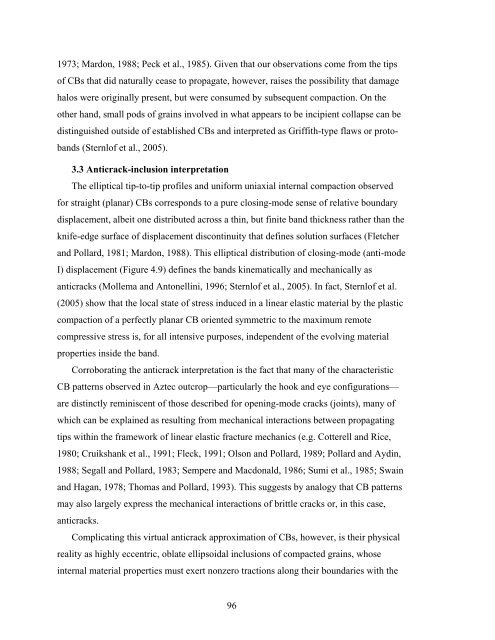structural geology, propagation mechanics and - Stanford School of ...
structural geology, propagation mechanics and - Stanford School of ...
structural geology, propagation mechanics and - Stanford School of ...
Create successful ePaper yourself
Turn your PDF publications into a flip-book with our unique Google optimized e-Paper software.
1973; Mardon, 1988; Peck et al., 1985). Given that our observations come from the tips<br />
<strong>of</strong> CBs that did naturally cease to propagate, however, raises the possibility that damage<br />
halos were originally present, but were consumed by subsequent compaction. On the<br />
other h<strong>and</strong>, small pods <strong>of</strong> grains involved in what appears to be incipient collapse can be<br />
distinguished outside <strong>of</strong> established CBs <strong>and</strong> interpreted as Griffith-type flaws or proto-<br />
b<strong>and</strong>s (Sternl<strong>of</strong> et al., 2005).<br />
3.3 Anticrack-inclusion interpretation<br />
The elliptical tip-to-tip pr<strong>of</strong>iles <strong>and</strong> uniform uniaxial internal compaction observed<br />
for straight (planar) CBs corresponds to a pure closing-mode sense <strong>of</strong> relative boundary<br />
displacement, albeit one distributed across a thin, but finite b<strong>and</strong> thickness rather than the<br />
knife-edge surface <strong>of</strong> displacement discontinuity that defines solution surfaces (Fletcher<br />
<strong>and</strong> Pollard, 1981; Mardon, 1988). This elliptical distribution <strong>of</strong> closing-mode (anti-mode<br />
I) displacement (Figure 4.9) defines the b<strong>and</strong>s kinematically <strong>and</strong> mechanically as<br />
anticracks (Mollema <strong>and</strong> Antonellini, 1996; Sternl<strong>of</strong> et al., 2005). In fact, Sternl<strong>of</strong> et al.<br />
(2005) show that the local state <strong>of</strong> stress induced in a linear elastic material by the plastic<br />
compaction <strong>of</strong> a perfectly planar CB oriented symmetric to the maximum remote<br />
compressive stress is, for all intensive purposes, independent <strong>of</strong> the evolving material<br />
properties inside the b<strong>and</strong>.<br />
Corroborating the anticrack interpretation is the fact that many <strong>of</strong> the characteristic<br />
CB patterns observed in Aztec outcrop—particularly the hook <strong>and</strong> eye configurations—<br />
are distinctly reminiscent <strong>of</strong> those described for opening-mode cracks (joints), many <strong>of</strong><br />
which can be explained as resulting from mechanical interactions between propagating<br />
tips within the framework <strong>of</strong> linear elastic fracture <strong>mechanics</strong> (e.g. Cotterell <strong>and</strong> Rice,<br />
1980; Cruikshank et al., 1991; Fleck, 1991; Olson <strong>and</strong> Pollard, 1989; Pollard <strong>and</strong> Aydin,<br />
1988; Segall <strong>and</strong> Pollard, 1983; Sempere <strong>and</strong> Macdonald, 1986; Sumi et al., 1985; Swain<br />
<strong>and</strong> Hagan, 1978; Thomas <strong>and</strong> Pollard, 1993). This suggests by analogy that CB patterns<br />
may also largely express the mechanical interactions <strong>of</strong> brittle cracks or, in this case,<br />
anticracks.<br />
Complicating this virtual anticrack approximation <strong>of</strong> CBs, however, is their physical<br />
reality as highly eccentric, oblate ellipsoidal inclusions <strong>of</strong> compacted grains, whose<br />
internal material properties must exert nonzero tractions along their boundaries with the<br />
96
















